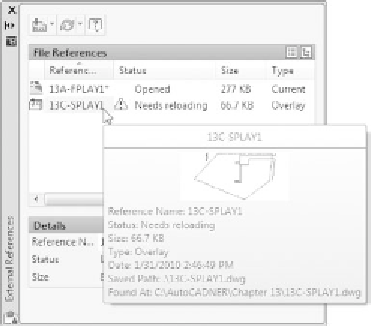Graphics Programs Reference
In-Depth Information
The palette shows most of the pertinent information regarding the
externally referenced files in the scene, including the status. When
you pause the cursor over a reference, a cue card displays a thumb-
nail image and additional information about that file. In this case,
the palette indicates that
13C-SPLAY1
needs reloading.
FiGuRE 13.21
The External References palette showing the status of the xrefs
8.
Select the
13C-SPLAY1
xref in the palette, right-click, and choose Reload
from the context menu.
This causes AutoCAD to reevaluate the external reference and update
the current drawing. The cabin drawing now shows the 10
′
-wide access
road from the site plan drawing (see Figure 13.22).
9.
Close the
13C-SPLAY1
file, but leave the
13A-FPLAY1
file open.
10.
Save the cabin drawing as
13A-FPLAY2.dwg
.
In this exercise, you saw how a host drawing is updated when the drawing that
is externally referenced is made current, modified, saved, and then reloaded as an
xref. Layers become an even more important tool when using external references.
You can set them up one way in the actual drawing and another way in the xref
of that drawing in a host file. In fact, you can externally reference the same draw-
ing into any number of host files; have the layer characteristics of visibility, color,
and linetype be different in each host file; and save them as such with each host
file. External referencing is a powerful feature of AutoCAD, and you'll learn more
about the possible applications of this tool toward the end of this chapter.


Search WWH ::

Custom Search